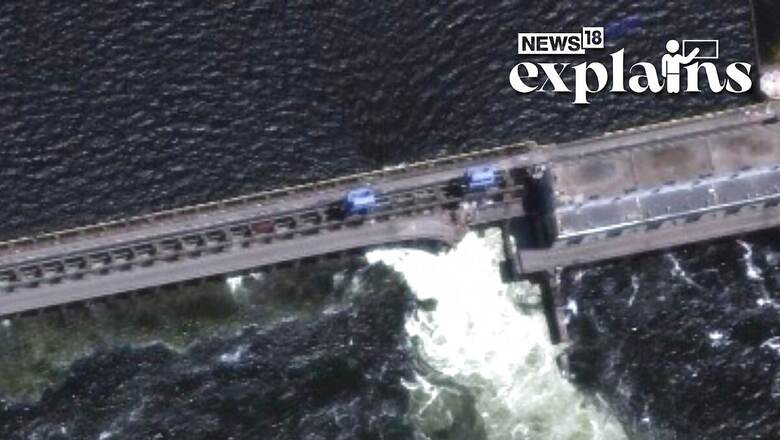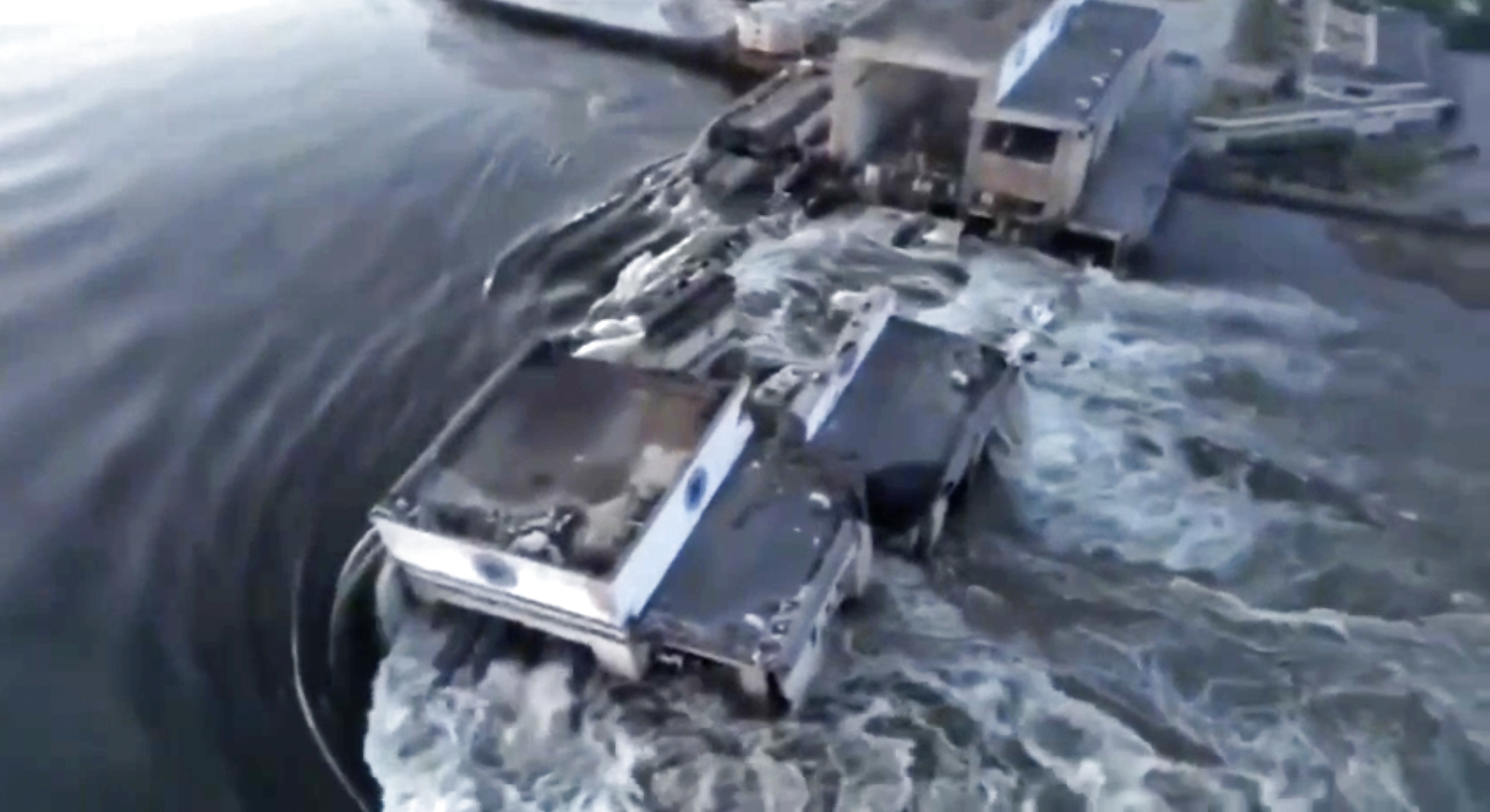
views
A dam located in southern Ukraine, which is under Russian control, was damaged on Tuesday. Both Kyiv and Moscow have traded accusations, blaming each other for the destruction of the dam. As a result, local residents were forced to evacuate due to the rising waters.
The authorities installed by Moscow claimed that the dam was partially destroyed due to “multiple strikes.” This incident occurred at a time when expectations were growing regarding the commencement of Ukraine’s anticipated offensive, as per AFP.
On the other hand, Ukraine has accused Russia of being responsible for the explosion at the Kakhovka hydroelectric plant, which led to the damaging of the dam.
“The terrorists’ goal is obvious — to create obstacles for the offensive actions of the armed forces,” Ukrainian presidential aide Mykhaylo Podolyak said.
Ukrainian President Ukrainian President Volodymyr Zelensky convened a meeting of his National Security Council over the Russian “war crime”, said his chief of staff, Andriy Yermak.
Several villages have been “completely or partially flooded” following damage to the dam and evacuations from the area have begun, a Ukrainian official said.
“About 16,000 people are in the critical zone on the right bank of the Kherson region,” Oleksandr Prokudin, head of the Kherson miliary administration, said on social media, adding that there was flooding in eight areas along the Dnipro River.
What is the Kakhovka Dam?
The Kakhovka dam, which has been under Russian control since the start of the Russian offensive in Ukraine, plays a crucial role in supplying water to the Crimean peninsula, which was annexed by Moscow in 2014.
Constructed in 1956 during the Soviet era, the dam is a significant piece of infrastructure in Ukraine, consisting of both concrete and earth components.

The news of the dam’s damage emerged following Ukrainian President Zelensky’s praise of his troops for their claimed advancements near the devastated city of Bakhmut. Meanwhile, Russia stated that it had successfully repelled a large-scale attack.
Zelensky expressed his appreciation to the Ukrainian soldiers in a video message shared on social media, stating, “Well done, warriors! We see how hysterically Russia reacts to any step we take there, all positions we take. The enemy knows that Ukraine will win.”
Earlier, Ukrainian Deputy Defence Minister Ganna Malyar had noted “some success” on the battlefield. “The Bakhmut sector remains the epicentre of the hostilities. We are advancing there on a rather wide front,” she said.
“The defensive operation includes counteroffensive actions. Therefore, in some sectors, we are conducting offensive actions,” Malyar added.
What Does Damage to the Dam Mean?
The fallout could have broad consequences: Flooding homes, streets and businesses downstream; depleting water levels upstream that help cool Europe’s largest nuclear power plant; and draining supplies of drinking water to the south in Crimea, which Russia illegally annexed.
The dam break added a complex new element to Russia’s ongoing war in Ukraine, now in its 16th month. Ukrainian forces were widely seen to be moving forward with a long-anticipated counteroffensive in patches along more than 1,000-kilometers of frontline in the east and south of Ukraine.
Ukraine’s nuclear operator Energoatom said in a Telegram statement that the blowing up of the dam “could have negative consequences” for the Zaporizhzhia Nuclear Power Plant, which is Europe’s biggest, but wrote that for now the situation is “controllable.”
The U.N.’s International Atomic Energy Agency wrote on Twitter that its experts were closely monitoring the situation at the plant, and there was “no immediate nuclear safety risk” at the facility.
Ukrainian authorities have previously warned that the dam’s failure could unleash 18 million cubic meters (4.8 billion gallons) of water and flood Kherson and dozens of other areas where hundreds of thousands of people live.
The World Data Center for Geoinformatics and Sustainable Development, a Ukrainian nongovernmental organization, estimated that nearly 100 villages and towns would be flooded. It also reckoned that the water level would start dropping only after 5-7 days.
A total collapse in the dam would wash away much of the left bank and a severe drop in the reservoir has the potential to deprive the nuclear plant of crucial cooling, as well as dry up the water supply in northern Crimea, according to the Ukraine War Environmental Consequences Working Group, an organization of environmental activists and experts documenting the war’s environmental effects.
Mykhailo Podolyak, a senior advisor to President Volodymyr Zelenskyy, said that “a global ecological disaster is playing out now, online, and thousands of animals and ecosystems will be destroyed in the next few hours.”
Videos posted online began testifying to the spillover. One showed floodwaters inundating a long roadway; another showed a beaver scurrying for high ground from rising waters.
Reply to Counteroffensive?
In May, Russia claimed to have seized the city of Bakhmut in eastern Ukraine, which was once the site of one of the longest and bloodiest battles of the war.
Ukraine has been preparing for a significant offensive to regain territory lost to Russia, but they have not announced the specific timing of the operation.
On Sunday, Ukrainian Defence Minister Oleksiy Reznikov posted a cryptic tweet quoting lyrics from the Depeche Mode song “Enjoy the Silence,” suggesting that words can only cause harm.
US President Joe Biden expressed his support for Ukraine’s anticipated counteroffensive on Monday.
When asked by AFP if he believed the expected Ukrainian pushback would be successful, President Biden responded by silently raising his hand and crossing his middle and index fingers. In recent weeks, the conflict has escalated with increased attacks on both sides of the border between Ukraine and Russia.
Military experts anticipate that Ukrainian forces will first probe Russian defenses to identify any weaknesses before launching a full-scale offensive.
‘Large-scale offensive’
Earlier on Monday, Russia’s defence ministry said “the enemy launched a large-scale offensive in five sectors of the front” on Sunday in the south of the Donetsk region.
Moscow said it had thwarted the offensive, killing a total of “1,500 servicemen” and destroying more than 100 armoured vehicles.
But the claims were dismissed on Tuesday by the boss of Russian mercenary group Wagner, Yevgeny Prigozhin, as “wild fantasies”.
Prigozhin has been embroiled in a public spat with Russia’s regular army and has accused Moscow’s military leadership of not supplying enough ammunition, among other criticisms.
Large parts of Donetsk have been held by pro-Moscow separatists since 2014.
It is one of four eastern Ukrainian territories that Russia formally annexed in September last year, along with Lugansk, Zaporizhzhia and Kherson, despite never fully controlling them.
The ministry posted what it said was a video of the battle, showing Ukrainian armoured vehicles coming under heavy fire.
Russian President Vladimir Putin’s top commander in Ukraine, Chief of the General Staff Valery Gerasimov, “was at one of the advanced command posts”, the ministry said.
The ministry later said it defeated “new attempts to pierce Russian defences” in southern Donetsk.
The Russian and Ukrainian claims could not be independently verified.


















Comments
0 comment